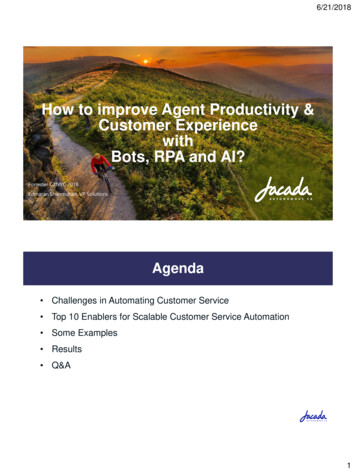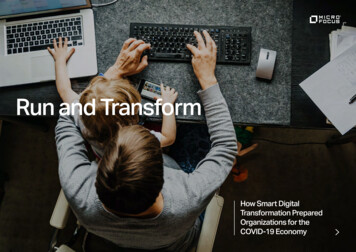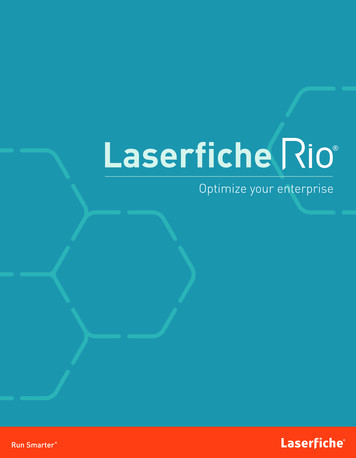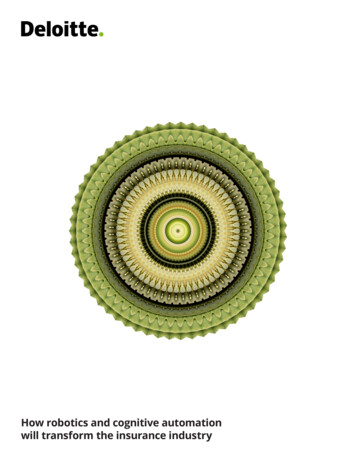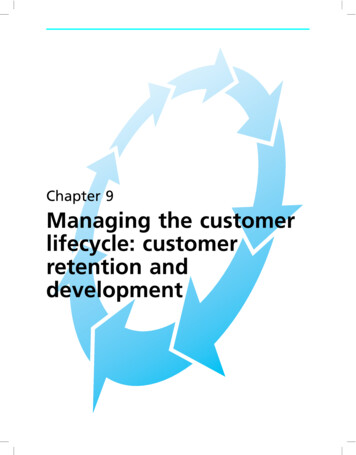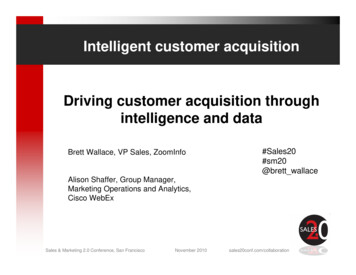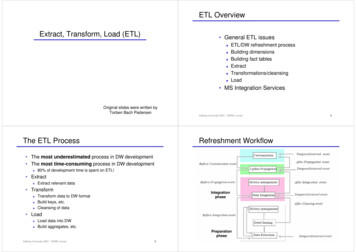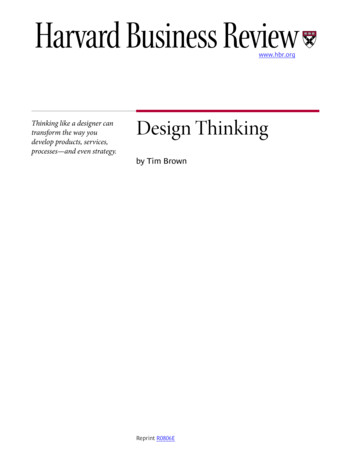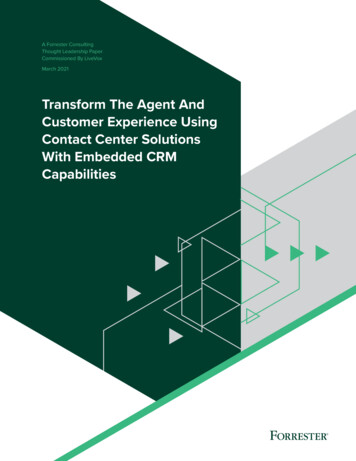
Transcription
A Forrester ConsultingThought Leadership PaperCommissioned By LiveVoxMarch 2021Transform The Agent AndCustomer Experience UsingContact Center SolutionsWith Embedded CRMCapabilities
Table Of Contents3 Executive Summary4 Customer And Agent ExperiencesAre Falling Short5 Integration Challenges BlockProgress8 Agent And Customer ExperiencesImprove With Integrated ContactCenter Solutions11 Key Recommendations12 AppendixProject Director:Sarah Brinks,Senior Market Impact ConsultantContributing Research:Forrester’s ApplicationDevelopment & Delivery researchgroupABOUT FORRESTER CONSULTINGForrester Consulting provides independent and objective research-basedconsulting to help leaders succeed in their organizations. Ranging in scope from ashort strategy session to custom projects, Forrester’s Consulting services connectyou directly with research analysts who apply expert insight to your specificbusiness challenges. For more information, visit forrester.com/consulting. 2021, Forrester Research, Inc. All rights reserved. Unauthorized reproductionis strictly prohibited. Information is based on best available resources.Opinions reflect judgment at the time and are subject to change. Forrester ,Technographics , Forrester Wave, RoleView, TechRadar, and Total Economic Impactare trademarks of Forrester Research, Inc. All other trademarks are the property oftheir respective companies. For additional information, go to forrester.com.[E-49741]
Executive Summary7 out of 10 contactcenter decisionmakers said theircontact centerplatform does nothave all the relevantcustomer informationand interactionhistory at the momentof engagement.The majority of firmssaid they wouldbe more likely topurchase a contactcenter platform withits own CRM thateasily integrated totheir legacy CRMand other platforms,assuming budgetwas not an issue.The contact center industry has been slow to change. Today, firms struggleto track and understand customers across various channels, making theagent experience, and therefore, the customer experience (CX) frustratingand difficult. As firms strive to improve customer and agent satisfaction, theyare turning to cloud-based integrated contact-center-as-a-service (CCaaS)and native CRM solutions.Key challenges around tracking the customer journey, serving customerson their channel of choice, and integrating with other systems are creatingcostly barriers to agent and customer experience excellence. Contactcenter decision-makers are eager to overcome those barriers with a contactcenter platform solution featuring its own CRM that easily integrates to theirorganization’s legacy CRM and other platforms.LiveVox commissioned Forrester Consulting to evaluate how integratedcontact center solutions help firms with their business operations, customerneeds, agent performance, and business outcomes. Integrated contact centersolutions accomplish several goals. First, they offer a more streamlined andeffective agent desktop. Second, they allow for consolidation of formallydisparate data sets spanning contact center operations, customer journeys,and customer records. Third, they provide a more simplified approach toserving customers on their channel of choice. Fourth, they serve as a baseupon which organizations can enable a wide range of AI applications thatwould otherwise be difficult to do on top of separate and disparate systems.And finally, they offer a more streamlined integrated suite that reduces overallexpense to acquire and manage. To explore this topic, Forrester conductedan online survey with 269 US contact center decision-makers who hold a titleof director or above. We found that firms struggle to track customers acrossvarious channels, resulting in a poor agent and customer experience.KEY FINDINGS› Integration with other systems is the top issue in managing CRM andcontact center technology. Three-quarters of surveyed decision-makerssaid it is challenging to manage upgrades and integrations for theirCRM and contact center platform and between them. These integrationchallenges persist across other systems within the organization, asdecision-makers ranked this as their top challenge in managing theirCRMs and contact center technology.› Contact center platforms are not given a full picture of their customers, andthat frustrates agents. Integration challenges restrict agents from accessingand synthesizing all relevant customer information and interaction history. Thisleads to clunky workflows, and it hinders the agent’s ability to quickly resolvecustomer issues and provide exceptional service. Customers can becomefrustrated with the time an interaction takes while agents are frustratedbecause they can’t do their job efficiently through no fault of their own.› Firms struggle to serve customers on their channel of choice. Only fortyfour percent of respondents believe their firm can orchestrate customerjourneys across all channels. Why is this? It’s because nearly 60% of firmssupport their channels on different systems, making it difficult to capture andutilize customer data. And a lack of real-time, channel-specific informationadds to the challenge of accessing and using customer data on the channelof their choice.3 Transform The Agent And Customer Experience Using Contact Center SolutionsWith Embedded CRM Capabilities
Customer And Agent Experiences AreFalling ShortAs consumer behavior changes, contact center decision-makers need totry to keep up. Firms struggle to support all the voice and digital channelstheir customers use, and it’s difficult to track and identify customers withconsistent IDs to take advantage of the capabilities on their customers’preferred channels. In surveying 269 contact center technology decisionmakers, we found that:› Orchestrating across all channels is a challenge for most firms.Contact centers today support a lot of channels, but they’re not alwaysthe channels their customers prefer. The most commonly supportedchannels are email and voice. Surveyed contact center decisionmakers also said their firms support chat, messaging apps, and SMS(see Figure 1). Agents accessing channels via different systems that donot easily integrate together can lead to an inability to serve customerson their channel of choice.› Agent desktops are inefficient. The agent experience can be difficultand needlessly frustrating due to inefficient desktops that createclunky workflows. Agents often must hunt across multiple channelsand applications to identify customers and to see their full histories.Only 39% of decision-makers said their firm uses tailored desktops andworkflows to augment their agents’ capabilities.IDENTIFIED GAPSAs contact center decision-makers prioritize use cases that supportself-service and the optimization of customer journeys, they also needto improve their workforce optimization capabilities to better identifycustomer and agent experience issues. In our survey we found that:› Agent performance analysis leaves gaps. Contact center decisionmakers use a range of tools and techniques to assess and analyzetheir agent performance. The top three techniques are ensuring agentsmeet training requirements, call/interaction scoring, and call/screenrecording. These assessment techniques are important, and they canlead to improved agent performance. However, less than half of firmsuse key assessment techniques such as speech and text analytics,KPI analytics, and competitive benchmarking. These more advancedanalytics can provide deeper insights into agent performance and drivemore focused coaching and training. In addition, firms can use them tospot areas of improvement for agent tools, business processes, andproducts. Similarly, tools to augment agent capabilities like internalchat, seamless channel switching, and tailored desktop workflows arethe least used today.› Customer experience analysis also leaves gaps. Nearly three-quartersof firms use customer satisfaction surveys to assess the quality of theircustomer experience. While customer satisfaction is important, it onlytells part of the story. Firms can gain deeper insight by assessing KPIs,sentiment analysis, and Net Promoter Scores more than they do today.14 Transform The Agent And Customer Experience Using Contact Center SolutionsWith Embedded CRM Capabilities2 out of 3 firmscannot orchestratecustomer journeysacross multiplechannels.
Figure 1“Which of the following channels does your contact center support today?”82% Email67% Voice61% Chat57% Messaging apps52% SMSBase: 269 US contact center director decision-makersSource: A commissioned study conducted by Forrester Consulting on behalf of LiveVox, December 2020Integration Challenges Block ProgressContact center decision-makers can’t wait for an ideal moment to makeupgrades to their systems; an ideal moment may never come. Meanwhile,challenges stack up against agents. Integration with other systems isthe top issue in managing CRM and contact center technology today.Integration issues create a ripple effect across the contact center, makingit more dificult to manage upgrades and to view data across all channels.They also complicate setup and support.The study found:› Contact center decision-makers identified key use cases forintegrated customer journey data. First, they would assist customerswith better self-service options. They would support agents with morespecific information about the customer’s identity and intent. Andthey would help business analysts by optimizing and enhancing thecustomer journey.Currently, agents assisting customers must search across four to sixapplications during a typical interaction, and this drives down efficiencyand time-to-resolution (see Figure 2). Relying on so many applicationsleads to inefficient workflows, and it hinders the agent’s ability toquickly resolve customer issues and provide personalized service.› Data challenges impact the customer experience. Data in the CRMand contact center is not unified. This makes it even more difficult forcontact center leaders to identify inefficiencies or gaps in the customerjourney across channels and to make improvements accordingly. Firmswaste time and money by bringing data together from multiple systems.Additionally, 43% of firms lack channel-specific data in real time, leavingagents frustrated and without a comprehensive view of the customersthey are trying to serve. Overcoming these integration challenges iskey to capturing, unifying, and utilizing customer journey data.5 Transform The Agent And Customer Experience Using Contact Center SolutionsWith Embedded CRM CapabilitiesMost decisionmakers said itis mildly to verychallenging to addapplications to theirfirm’s existing CRMor legacy platform.
Figure 2“How many applications do your agents have open during a typical interaction with a customer?”49%30%16%5%1 to 3 differentapplications4 to 6 differentapplications7 to 10 differentapplicationsMore than 10 differentapplications“What limitations do you have capturing and utilizing customer journey data?”59% Customer identity varies by channel and creates integration problems.59% Channels are supported by different systems, which creates integration limitations.51% Options available are complex to set up and support.39% We cannot integrate customer journey and profile data across all channels.39% We cannot integrate and utilize data across channels.“How challenging is it for yourorganization to manage upgradesand integrations for your CRM?”“How challenging is it for yourorganization to manage upgradesand integrations for your contactcenter technology?”“How challenging is it for yourorganization to manage theintegration between your CRM andcontact center technology?”75%76%77%Mildly to very challengingMildly to very challengingMildly to very challengingBase: 269 US contact center director decision-makersSource: A commissioned study conducted by Forrester Consulting on behalf of LiveVox, December 20206 Transform The Agent And Customer Experience Using Contact Center SolutionsWith Embedded CRM Capabilities
INTEGRATION CHALLENGES CREATE POOR EXPERIENCES› Firms struggle to see the complete customer journey. The topchallenge for contact center decision-makers is integration withother systems in their technology stacks. This is followed closely bychallenges with viewing data across all channels. Moreover, contactcenter decision-makers struggle with varying customer identitiesacross channels (see Figure 2). An inability to track customers acrosschannels leaves agents without the relevant customer information andinteraction history they need to serve customers on their preferredchannel and in their moment of need.› Managing upgrades and integrations is challenging across theCRM and contact center platforms. Three-quarters of contact centerdecision-makers said it is mildly to very challenging to manageupgrades and integrations for their firm’s CRM (see Figure 2). It is evenmore difficult with contact center technology. Firms waste a lot ofeffort, time, and resources due to complex systems that do not easilycommunicate across the ecosystem — not even with IT effort.INTEGRATION CHALLENGES CAUSE IT INEFFICIENCY› Disparate systems drive the need for large IT teams. IT teams oftenhave the complex and thankless job of supporting the contact center.Firms struggle to effectively use their customer journey data becausetheir channels are supported by different systems that IT teams mustmaintain and integrate separately. Most firms have a minimum of 10to 15 IT staff members currently supporting their contact center, whilenearly a quarter of firms have more than 20 IT staff members who keepthe contact center running (see Figure 3).Nearly threequarters ofrespondentssaid a lack ofrelevant customerinformation andinteraction history intheir firm’s contactcenter platformis a limitationto trialing anddeploying customerjourney historyat the moment ofinteraction.Figure 3“How many IT staff members currently support your contact center?”18% More than 2017% 16 to 1931% 10 to 1519% 6 to 913% 3 to 52% 1 to 2Base: 269 US contact center director decision-makersSource: A commissioned study conducted by Forrester Consulting on behalf of LiveVox, December 20207 Transform The Agent And Customer Experience Using Contact Center SolutionsWith Embedded CRM Capabilities
› Barriers impact a typical interaction with a customer. Let’s pause andthink about how these integration challenges affect a typical customerinteraction. Here’s a scenario: A customer calls the contact center tocheck on a service. That customer was added through a merger. Theagent tries to bring up the customer’s information and history, but theycan’t access that data. This requires the agent to open the applicationwith the merged company’s data to see the customer’s history. Butthe agent is unfamiliar with the application, and the customer has adifferent ID in that system. Along the way, the customer has to repeatthemself multiple times. The customer is frustrated about the time theinteraction takes and they do not feel validated by the agent. The agentis frustrated because they can’t do their job efficiently through no faultof their own.Agent And Customer ExperiencesImprove With Integrated Contact CenterSolutionsToday’s vibrant contact center market is defined by the need to shiftto multitenant, integrated suites that overlay customer interactionmanagement, self-service, embedded AI, and enhanced workforceoptimization. These elements have come together to lay the groundworkfor change and differentiation in the CCaaS market.2 Contact centerdecision-makers in our study were clear that they are ready for anintegrated solution that has a built-in CRM and external CRM integrationcapabilities. The study found:› Improving agent and customer experience is top of mind. In orderto win, serve, and retain customers, firms must adopt a customerobsessed mindset. They need to serve their customers on theirchannel of choice and in their moment of need. As self-servicecapabilities improve due to AI, it puts increased pressure on agentsto deal with the remaining issues that are more complex and difficult.When this is handled well, it boosts customer satisfaction. This can onlybe accomplished if agents have the technology in place to seamlesslyserve customers across all channels with relevant and comprehensivedata in real time. This requires integration across the CRM, a contactcenter platform with more consistent uptime, and system support (seeFigure 4).8
Figure 4“Please rank the top 5 most critical benefits from having a CRM and contact center solution from the same vendor?”Rank 1Rank 2Rank 3Rank 4Improved customer experience20%Improved agent experience16%Easier configuration15%Better integration with other existing systems14%Reduced cost of solution13%7%Reduced maintenance of solution12%14%More consistent uptime/system support10%Rank 5%13%12%9%16%17%17%12%13%17%Base: 269 US contact center director decision-makersSource: A commissioned study conducted by Forrester Consulting on behalf of LiveVox, December 2020› If the budget is available, decision-makers will invest in integratedcontact center solutions. Assuming budget isn’t an issue, mostrespondents said their firm would purchase an integrated CCaaSsolution with its own built-in CRM that is then integrated with anexternal CRM (see Figure 5). Though contact center decision-makerstypically wait for compelling events before making major upgrades,the cost of waiting may be too high. Agent time and resources arenot being used efficiently, customer satisfaction scores decrease,and complexity increases. More consistent uptime and reducedmaintenance costs can help offset the up-front cost of an integratedcontact center solution.Figure 5“Which of the following best matchesyour likelihood to purchase if you hadaccess to a contact center platformwith its own CRM that easily integratedto your legacy CRM and other platforms(assuming budget is not an issue)?”69%Cloud-based solutions ease the challenges firms experience withsoftware upgrades, integrations, and the up-front expense ofinfrastructure needed for on-premises systems. They are also morecost-effective, making the up-front investment less of a burden in thelong run.› An integrated contact center solution is the ideal scenario. Integratedcontact center solutions have many critical benefits. Most importantly,they improve agent and customer experiences (see Figure 6).Customers can be served on their channel of choice more efficientlyas agents can access their information from a centralized system. Anintegrated contact center solution provides a smoother workflow foragents, and that allows them to reduce call avoidance and improve onKPIs like average handle time. Select a CCaaS vendor that meets yourneeds for service, support, and integrations.9 Transform The Agent And Customer Experience Using Contact Center SolutionsWith Embedded CRM Capabilities20%10%More likelyLess likelyIt would notaffect ourpurchasingplans.Base: 269 US contact center director decision-makersSource: A commissioned study conducted byForrester Consulting on behalf of LiveVox,December 2020
Using an integrated CCaaS solution with its own built-in CRM and externalCRM-integration capabilities is a key step to having a comprehensiveomnichannel approach. It allows customer-service leaders to trial andimplement new and efficient contact flows. On the other hand, the costand complexity of trying new contact flows with legacy on-premisessystems would cause many firms to simply forgo the effort. To adapt tochanging consumer appetites for digital interfaces, they’ll need flexible,cloud-based solutions for seamless cross-channel interactions.3Figure 6“In an ideal scenario where your organization had an integrated contact-center-as-a-service (CCaaS) and CRM system,please rank the following attributes from most valuable to least valuable.”Top 3 most valuable52% Improved customer
center platform solution featuring its own CRM that easily integrates to their organization’s legacy CRM and other platforms. LiveVox commissioned Forrester Consulting to evaluate how integrated contact center solutions help firms with their business operations, customer needs, agent perf
